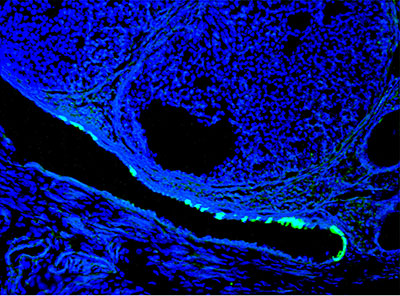Scientists discover origin of aggressive ovarian cancer
By Krishna Ramanujan

Cornell researchers have discovered a likely origin of epithelial ovarian cancer (ovarian carcinoma), the fifth leading cause of cancer death among women in the United States.
Pinpointing where this cancer originates has been difficult because 70 percent of patients are in advanced stages of disease by the time it is detected. Because the origin of ovarian carcinoma development is unknown, early diagnostic tests have so far been unsuccessful.
Some epithelial cancers are known to occur in transitional zones between two types of epithelium (layers of tissue that line the body and organs and form glands), while others originate in epithelial tissue stem cells. All organs have the capacity for regeneration, which is done by adult stem cells located in areas of each organ called stemcell niches.
With this knowledge, the researchers discovered a novel stem cell niche for the ovarian surface epithelium in mice and showed that ovarian carcinoma preferentially originates from stem cells found in that niche, according to the study published March 6 in the journal Nature. This stemcell niche lies in a transitional area known as the hilum region, a layer of cells that links the ovary to the rest of the body.
"We now know where these cells are located [in mice], so we can look in humans in those areas," said Alexander Nikitin, professor of pathology, leader of the Cornell Stem Cell Program and the paper's senior author. Andrea Flesken-Nikitin, a postdoctoral researcher in Nikitin's lab, is the paper's lead author.

"The findings also provide a guide for us to look for stem cell niches [and sources of cancer] in other transitional zones in other organs," Nikitin added.
The researchers proved that stem cells from the hilum region were indeed highly prone to ovarian carcinoma, using the most current genetic research techniques.
The researchers first found that cells in the hilum region express a known marker for stem cells, called ALDH1. They then isolated ALDH1 positive cells, sequenced their genetic profiles and found many markers previously reported for stem cells in other organs.
One of these markers, LGR5, has been studied for intestinal stem cells by other researchers who have bred special mice and developed an advanced method that uses a fluorescent protein to follow stem cells. The gene encoding the fluorescent protein is passed down from a stem cell to each generation of daughter cells, thereby marking the lineage. The technique "allows you to see the fate of stem cells over time," said Nikitin. Using the method on the hilum cells, "we showed that cells from the hilum area spread around the whole ovary."
Finally, the researchers microdissected ovary and hilum cells, inactivated two tumor suppressor genes p53 and Rb1, whose pathways are commonly altered in human aggressive ovarian carcinoma, and injected cells into the abdominal cavity of mice. Very few tumors developed in the mice injected with ovary cells, but almost all of the mice injected with hilum cells died after developing aggressive, metastasizing cancers that were similar to human ovarian carcinomas.
In future work, the researchers will look for stem cells and sources of cancer in transitional zones in the human ovary and other organs, such as the stomach, rectum and uterine cervix.
The research was funded by the National Institutes of Health, National Cancer Institute, New York State Stem Cell Science, Marsha Rivkin Center for Ovarian Cancer Research and Russian Ministry of Education and Science.
Media Contact
Get Cornell news delivered right to your inbox.
Subscribe